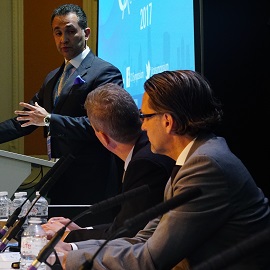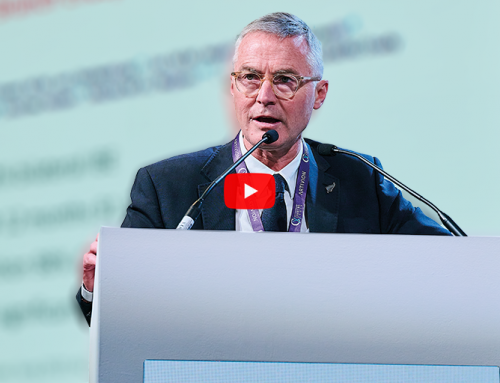
Tuesday’s CX Aortic Edited Cases session featured exciting and engaging standing-room only case presentations, including Andrew Holden’s (Auckland, New Zealand) first-in-man implantation of the Ovation Alto (Endologix). Covering thoracic, juxtarenal and abdominal cases, the packed-out session explored innovative techniques, novel devices and a veritable array of practical tips and tricks, offering an invaluable resource for delegates.
The format of this session, a brainchild of the programme directors of the course, involved a short, punchy introduction of the patient and explanation of why the procedure was necessary. Then, there was a 10-minute edited video format that could be stopped and replayed at will, including in slow-motion by the chairman in order to understand the technique. This was followed by a 15-minute question and answer session that could completely focus on the technique.
Fiona Rohlffs (Hamburg, Germany) said: “The format of CX Aortic Edited Cases was excellent at bringing forth aspects of different techniques and devices. I found the presentations on the aortic arch particularly interesting.”
The first half of the day was devoted to two thoracic case sessions. Highlights of the first session—chaired by Stéphan Haulon (Lille, France) and moderated by Andrew Holden (Auckland, New Zealand)—included a focus on the technical aspects of ascending aortic procedures from Rodney White (Torrance, USA) and Michael Dake’s (Stanford, USA) discussion of the thoracic arch endograft in arch zones 0, 1 and 2.
Ascending aortic endovascular procedures are uniquely challenging, White told the audience. “Negotiating the curvature of the ascending aortic arch, proximal fixation near the aortic valve and coronaries, distally potential impingement of the innominate and left carotid, severe haemodynamic forces and the potential for retrograde dissection are all limitations. An average of 1cm larger than the descending aorta, the ascending aorta is only about one quarter of its length.” White explained to CX Daily News, “There is also about 10% variation in diameter during the cardiac cycle in the descending aorta, compared to 15–20% in the ascending aorta with a significant 3D rotational component.”
He took the audience through the evolution of the hybrid operating room—designed to accommodate the full spectrum of open and endovascular procedures—something he argued is “an essential component for ascending aortic procedures”. A multidisciplinary team is required to fully address potential complications, from cardiac perforation to coronary artery occlusion, he explained. “Catheter-based bailout procedures for catastrophic events such as aortic valve entrapment and/or coronary artery occlusion must be rehearsed,” White insisted, with potential components and personnel available without hesitation. In cases where potential leaflet entrapment might occur, momentary cardiac arrest may be used to position the valves in a closed position (in addition to rapid pacing which is routinely used in these cases), he explained, to prevent valve leaflet entrapment.
“Transfemoral deployment systems for delivery of aortic devices tend to orient obliquely in the ascending aorta just above the valve due to significantly longer outer curve length compared to the inner curvature.” In cases where there is a long outer curve with a horizontal heart appearance, White explained, “Transapical deployment can significantly increase the accuracy.”
He went on to highlight the additional significant limitation for all cardiac and ascending catheter-based procedures of a significant incidence of delayed embolic events (stroke). Incorporation of intraprocedural protection devices may be possible, he asserted, although the delayed incidence of strokes despite 48 hour pre-procedure treatment with antiplatelet agents persists. “The problem is exaggerated in this patient population which frequently presents with ischaemic events, complicating the diagnosis and prevention of subsequent events,” he concluded.
The development over the last 20 years of endovascular techniques for the management of abdominal and thoracic aortic diseases has dramatically changed clinical practice, Michael Dake (Stanford, USA) explained in the following presentation. Since its introduction, thoracic endovascular aortic repair (TEVAR) has progressed “from an alternative therapy in patients at high risk for open surgical repair to a generally adopted procedure that is in widespread clinical use.”
“Enthusiasm for this less-invasive thoracic aortic therapy has fuelled interest in extending its application to address disease in more proximal aortic segments, including the aortic arch where critical branch vessels exist,” Dake told CX Daily News. “The lack of available endografts that incorporate an integrated branch graft led to the creation of hybrid procedures with bypass grafts to arch branches combined with TEVAR and the use of parallel branch vessel endografts including chimney, periscope or snorkel (ChimPS) devices alongside or via in situ fenestration of standard aortic endografts for a total endoluminal repair.”
A preferred solution to address aortic arch pathology would use a branched stent graft created to allow endovascular branch vessel reconstruction, Dake explained. “The Thoracic Branch Endoprosthesis (TBE, Gore) is a uniquely designed single-side branch device,” he said. “The initial perioperative results of the US feasibility multicentre trial to study its use for the treatment of patients with distal arch and descending thoracic aortic aneurysms involving the left subclavian artery were recently detailed.” Dake then presented the mid-term follow-up outcomes (mean follow-up, 13 months; range, 22–815 days) for patients undergoing TBE placement into Ishimaru Zones 0, 1, and 2.
The second thoracic session, chaired by Tilo Kölbel (Hamburg, Germany) and moderated by Dittmar Böckler (Heidelberg, Germany), included highlights such as Ali Azizzadeh’s (Houston, USA) explanation of the Valiant Navion device (Medtronic) and Stéphan Haulon’s discussion of radiation exposure reduction in the context of fenestrated endovascular aneurysm repair (FEVAR) with fusion imaging.
The Valiant Navion thoracic stent graft system is an investigational device being studied in a prospective, multicentre, non-randomised single-arm trial at 37 sites in North America and Europe, Azizzadeh told the CX audience, and is expected to enrol up to 100 subjects. The Navion system introduces several design enhancements to the current Valiant Captivia system (Medtronic), including two proximal graft configurations with a proximal closed web with tip capture.
The case described by Azizzadeh involved a 58-year-old white female with a fusiform 5.3cm descending thoracic aneurysm. Aortic diameter proximal to the aneurysm was 30mm and the distal aortic diameter was 25mm.
The patient was a smoker with a history of hyperlipidaemia and cardiac arrhythmia. American Society of Anaesthesiologists physical classification of the patient was III (severe systemic disease) and vessel access was uninhibited, with no noted tortuosity or calcification.
Two Valiant Navion devices were selected for the case, a proximal 34x28x175 FreeFlo graft, and a distal 31x31x175 Closed Web graft. Access was percutaneous and obtained via the right femoral artery. Azizzadeh reported that the final angiography showed no endoleaks, and that the stent graft was patent and resulted in no device deficiencies.
Stéphan Haulon then spoke about reducing radiation exposure during complex endovascular repair. Speaking to CX Daily News, Haulon discussed the steps that he and his team take at their high-volume aortic centre to avoid exposure when using image fusion. He said, “In our experience, [EVAR with image fusion], together with strict adherence to the ‘As low as reasonably achievable (ALARA)’ principle, leads to dose reduction. In a recent evaluation of our first 100 aortic endovascular repairs performed with image fusion, we observed significant reduction in radiation exposure for all types of EVAR procedures (including thoracic and FEVAR) for both patients and physicians, as well as a significant reduction in contrast media volume during complex repairs (FEVAR).”
Haulon believes there are three main reasons for this. The first is the fusion technique used to overlay 3D images on live fluoroscopy, in which preoperative computed tomography angiography (CTA) is used to generate the 3D model, and fusion registration is performed with two fluoroscopic orthogonal shots (AP and lateral) of the spine to align the bone sub-volume of the CTA on bony landmarks. “This protocol is fast, easy, and almost radiation free,” Haulon said.
The second reason, Haulon said, is strict application of the ALARA principle at all times, while the final factor is that his team’s imaging system is “fully controlled at the operating table, which has also proved to reduce radiation exposure when compared to a radiographer controlled imaging system.”
Following Haulon’s case presentation, Gustavo Oderich (Rochester, USA) discussed the pitfalls and benefits of various preloaded systems to facilitate fenestrated or branched endovascular aneurysm repair. “Lower extremity and pelvic ischaemia from prolonged transfemoral sheath has been associated with increased mortality and rates of spinal cord injury,” he explained, before concluding that “preloaded guidewire systems can be used to facilitate catheterisation of fenestrations and branches, and are useful to minimise ischaemia”
Other topics covered included a first-in-man Ovation Alto case presented by Andrew Holden in the juxtarenal session, Dittmar Böckler’s tips and tricks for on-table imaging to detect EVAR endoleak in the first abdominal session, and Jean-Paul de Vries’ (Nieuwegein, The Netherlands) innovative technique for endoanchor in the primary and secondary situations in the final abdominal session.
Other presentations in this session included: Martin Funovics (Vienna, Austria) on the RelayBranch and RelayScallop (Bolton Medical) for arch disease; Anders Wanhainen (Uppsala, Sweden) on treating type B dissection with Zenith Dissection (Cook Medical); Andrew Holden on the technique for branched grafts during chimney or juxtarenal aortic procedures, and on Aorfix and its new Intelliflex delivery system (both Lombard Medical) for improved control in challenging anatomies; Stéphan Haulon on complex FEVAR with BeGraft bridging stents (Bentley); Guido Rouhani (Frankfurt, Germany) on combining Zenith Iliac Branch and Zenith Alpha (both Cook Medical) to treat abdominal and iliac aneurysms; Jost Philipp Schaefer (Kiel, Germany) on E-tegra and E-liac (both JOTEC) for aortoiliac EVAR; and Paul Hayes (Cambridge, UK) on Altura (Lombard Medical) for infrarenal EVAR.







